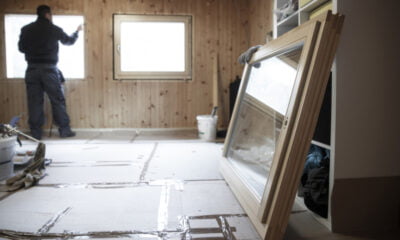

Environment
How to Limit Your Environmental Impact After a Home Remodel
Embracing green practices can help protect the planet, but they can sometimes be a challenge to put into action. However, the extra effort is often well worth it; not only will you be making a positive impact on the environment, but you may also save some money by doing so. And when it comes to a home improvement project, you’ll want to go as green as possible. High-efficiency appliances and sustainable building materials can make a huge difference in how well your home functions (and they might even lower your monthly energy bills).
But if you aren’t inclined to fill your home with fancy features or responsibly sourced materials, you can still do your part by making sure the cleanup of your home renovation is an eco-friendly one. You might be surprised to learn that construction and demolition materials — like concrete, brick, wood, asphalt, metal, glass, plastics, and other products — present a big problem when they’re not disposed of properly. In fact, the EPA estimates that in 2014, 534 million tons of construction and demolition debris were generated in the United States. That’s more than twice the amount of generated municipal solid waste. Building debris alone accounts for one-third of all solid waste in America. And although a lot of these discarded materials end up in our nation’s landfills, a huge portion of it could be recycled or reused in some way.
By putting these products to better use, we’d not only reduce environmental impact but would also keep building project expenses down, stimulate the economy via the recycling industry, and conserve valuable landfill space. And if that’s not enough incentive to be more thoughtful about your post-remodeling plans, consider the fact that you could get a nice tax write-off for the furniture, appliances, and textiles you choose to donate instead of leaving out by the curb! So how can you make a difference during and after your next renovation? Keep reading to find out.
Consider Using Sustainable Materials When Possible
If you really want to reduce your carbon footprint, you’ll probably want to use at least some eco-friendly components in your redesign. Whether it’s reclaimed flooring, recycled countertops, LED lighting, green or solar roofing, high-efficiency appliances, or even low-VOC paints (which have little to no harmful chemicals), you’ll find that it’s never been more convenient to make an environmentally responsible choice. You may also want to give some thought to forgoing the brand-spanking-new for pre-owned, which can allow you to give new life to a higher-end product without paying top dollar.
Should eco-friendly options be a top priority to your family, you should also take steps to work with a truly eco-conscious contractor on your project. These days, a lot of professionals may imply that they follow green building standards without having the credentials to back it up. There are numerous kinds of certifications that show a contractor has the proper knowledge and experience. You’ll want to check for those, rather than assuming that a company’s “greenwashed” marketing means they follow recognized eco-friendly standards.
When you are buying sustainable materials, it is important to treat them as an investment. Don’t be afraid to take out a loan if you need to. Even a payday loan can be a good idea if you have bad credit, because the improvements will pay themselves over time.
Repurpose and Reuse What You Can
Whether or not you decide to incorporate newer, eco-friendly elements into your design, you can practice environmental responsibility by repurposing and/or reusing components you already own. Instead of tossing out scrap metal, old tools, or rocks, you could create an art piece in your outdoor space or a decorative fence to add character and privacy to your property. And rather than buying all new furniture, cabinets, sinks, or flooring, see whether these items might be able to be installed elsewhere in your home. You can instantly give your laundry room, garage, or basement a facelift — or you may be able to save yourself time and money during a demolition by refacing your current cabinets and adding new hardware to freshen up the kitchen or bathroom. As long as these pieces are in good shape, you can go the green route (and keep green in your wallet) by repurposing or revitalizing whatever you can.
Donate or Sell What You Don’t Need
You can help the earth and a worthy cause by opting to donate gently used furniture, appliances, and even some construction and renovation materials to local nonprofit organizations. This will keep these items out of landfills and will help others in need — plus, you can write-off your donation on your tax return. You can donate working appliances (like refrigerators, washing machines, stoves, and sometimes dishwashers), fixtures (like toilets, bathtubs, and sinks, as long as they don’t have chips in the porcelain), cabinets, doors, windows, flooring, light fixtures, knobs and handles, and even lumber. There are also organizations that allow you to donate carpeting for reuse or recycling. Habitat For Humanity’s ReStore locations are a good one-stop shop where you can unload these items for a good cause, but there are many other charities that would be grateful to receive many of these products.
If you’ve got an antique, rare, or unique items and could use some extra cash for your own renovation, you could potentially sell them to a collector or someone who restores historic homes. For example, vintage windows, sinks, cabinets, and vanities are often in-demand. Just make sure that the site you use is reputable and that you take precautions if a buyer comes to see the item in person.
When All Else Fails, Remember to Recycle
Although more than 70% of the million tons of garbage we produce on a yearly basis can be recycled, it’s easy to underestimate just how much you could recycle in your home. Metal, porcelain, ceramics, fabrics, tile, brick, concrete, asphalt, and more can all be sent to the recycling plant to be turned into new materials. In California, builders actually have to recycle 90% of their inert materials. One California family recycled a whopping 80% of their entire home (and earned a $100,000 tax write-off in the process).
Keep in mind that each kind of material needs to be dealt with in a different way prior to recycling. Metals, for instance, should be cleaned and sorted before you can sell them for scrap. You can also send scrap back to the manufacturer to be melted down. Recycling treated timber differs from recycling untreated timber, so you’ll want to talk to recycling services in your area to ensure you’re following proper procedures. And although the steel and other metals in your appliances can be recycled, you’ll need to remove refrigerants and compounds first. You can also work with a green demolition company (which may have ties to local charities) to ensure everything is recycled or reused in the way it should be.
Clean Up Your Reno Clean-Up
Sure, it may be a whole lot easier to throw renovation waste materials in a dumpster and have them hauled away. But if you do that, you’ll be personally contributing to our planet’s plight. By taking the time to donate, reuse, and recycle the materials you can, you’ll feel proud of the positive impact you make for the Earth and for families in need. And don’t forget: your efforts can make you some extra dough, too. It may take a bit of extra planning, but with so many easy ways to put these materials to good use, it’s never been more convenient to make the old new again.


 Environment10 months ago
Environment10 months agoAre Polymer Banknotes: an Eco-Friendly Trend or a Groundswell?

 Environment12 months ago
Environment12 months agoEco-Friendly Home Improvements: Top 7 Upgrades for 2025

 Features9 months ago
Features9 months agoEco-Friendly Cryptocurrencies: Sustainable Investment Choices

 Features10 months ago
Features10 months agoEco-Friendly Crypto Traders Must Find the Right Exchange





























